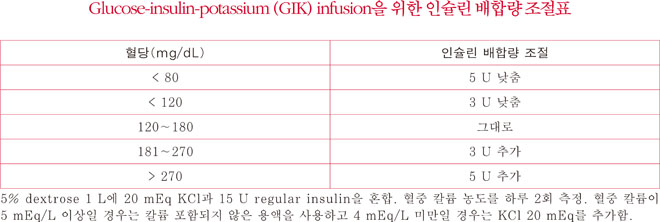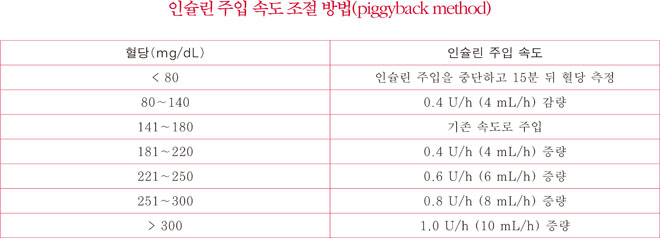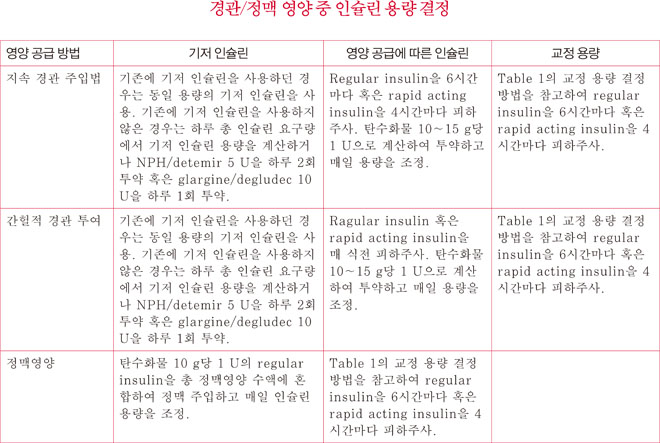Abstract
In hospitalized patients, hyperglycemia is frequently observed in patients with and without diabetes. Inpatient hyperglycemia worsens outcomes, potentially leading to infection, post-operative complications, and even death. Therefore, it is important to control blood glucose level in an inpatient setting. However, in these patients, it can be difficult to achieve adequate glycemic control due to the disease itself (e.g., infection), treatment drugs (e.g., corticosteroids), procedures requiring fasting, or enteral/parenteral nutrition therapy. In most cases, insulin therapy is required. We reviewed the insulin treatment regimens in hospitalized patients.
Figures and Tables
Table 1
Supplemental bolus insulin scale

Adapted from the article of Umpierrez et al. (Diabetes Care 2007;30:2181-6) [14] with original copyright holder's permission. The very sensitive column is added to the original table.
References
1. Moss SE, Klein R, Klein BE. Risk factors for hospitalization in people with diabetes. Arch Intern Med. 1999; 159:2053–2057.

2. Umpierrez GE, Hellman R, Korytkowski MT, Kosiborod M, Maynard GA, Montori VM, Seley JJ, Van den Berghe G. Endocrine Society. Management of hyperglycemia in hospitalized patients in non-critical care setting: an endocrine society clinical practice guideline. J Clin Endocrinol Metab. 2012; 97:16–38.

3. Pomposelli JJ, Baxter JK 3rd, Babineau TJ, Pomfret EA, Driscoll DF, Forse RA, Bistrian BR. Early postoperative glucose control predicts nosocomial infection rate in diabetic patients. JPEN J Parenter Enteral Nutr. 1998; 22:77–81.

4. Capes SE, Hunt D, Malmberg K, Gerstein HC. Stress hyperglycaemia and increased risk of death after myocardial infarction in patients with and without diabetes: a systematic overview. Lancet. 2000; 355:773–778.

5. Umpierrez GE, Isaacs SD, Bazargan N, You X, Thaler LM, Kitabchi AE. Hyperglycemia: an independent marker of in-hospital mortality in patients with undiagnosed diabetes. J Clin Endocrinol Metab. 2002; 87:978–982.

6. Carson JL, Scholz PM, Chen AY, Peterson ED, Gold J, Schneider SH. Diabetes mellitus increases short-term mortality and morbidity in patients undergoing coronary artery bypass graft surgery. J Am Coll Cardiol. 2002; 40:418–423.

7. Yong PH, Weinberg L, Torkamani N, Churilov L, Robbins RJ, Ma R, Bellomo R, Lam QT, Burns JD, Hart GK, Lew JF, Mårtensson J, Story D, Motley AN, Johnson D, Zajac JD, Ekinci EI. The presence of diabetes and higher HbA1c are independently associated with adverse outcomes after surgery. Diabetes Care. 2018; 41:1172–1179.

8. Kwon S, Thompson R, Dellinger P, Yanez D, Farrohki E, Flum D. Importance of perioperative glycemic control in general surgery: a report from the surgical care and outcomes assessment program. Ann Surg. 2013; 257:8–14.

9. van den Boom W, Schroeder RA, Manning MW, Setji TL, Fiestan GO, Dunson DB. Effect of A1C and glucose on postoperative mortality in noncardiac and cardiac surgeries. Diabetes Care. 2018; 41:782–788.

10. Moghissi ES, Korytkowski MT, DiNardo M, Einhorn D, Hellman R, Hirsch IB, Inzucchi SE, Ismail-Beigi F, Kirkman MS, Umpierrez GE. American Association of Clinical Endocrinologists. American Diabetes Association. American Association of Clinical Endocrinologists and American Diabetes Association consensus statement on inpatient glycemic control. Diabetes Care. 2009; 32:1119–1131.

11. Amsterdam EA, Wenger NK, Brindis RG, Casey DE Jr, Ganiats TG, Holmes DR Jr, Jaffe AS, Jneid H, Kelly RF, Kontos MC, Levine GN, Liebson PR, Mukherjee D, Peterson ED, Sabatine MS, Smalling RW, Zieman SJ. ACC/AHA Task Force Members. Society for Cardiovascular Angiography and Interventions and the Society of Thoracic Surgeons. 2014 AHA/ACC guideline for the management of patients with non-ST-elevation acute coronary syndromes: executive summary: a report of the American College of Cardiology/American Heart Association Task Force on Practice Guidelines. Circulation. 2014; 130:2354–2394.

12. 14. Diabetes care in the hospital: Standards of Medical Care in Diabetes-2018. Diabetes Care. 2018; 41:Suppl 1. S144–S151.
13. Inzucchi SE. Clinical practice. Management of hyperglycemia in the hospital setting. N Engl J Med. 2006; 355:1903–1911.

14. Umpierrez GE, Smiley D, Zisman A, Prieto LM, Palacio A, Ceron M, Puig A, Mejia R. Randomized study of basalbolus insulin therapy in the inpatient management of patients with type 2 diabetes (RABBIT 2 trial). Diabetes Care. 2007; 30:2181–2186.

15. Queale WS, Seidler AJ, Brancati FL. Glycemic control and sliding scale insulin use in medical inpatients with diabetes mellitus. Arch Intern Med. 1997; 157:545–552.

16. Umpierrez GE, Smiley D, Jacobs S, Peng L, Temponi A, Mulligan P, Umpierrez D, Newton C, Olson D, Rizzo M. Randomized study of basal-bolus insulin therapy in the inpatient management of patients with type 2 diabetes undergoing general surgery (RABBIT 2 surgery). Diabetes Care. 2011; 34:256–261.

17. Umpierrez GE, Smiley D, Hermayer K, Khan A, Olson DE, Newton C, Jacobs S, Rizzo M, Peng L, Reyes D, Pinzon I, Fereira ME, Hunt V, Gore A, Toyoshima MT, Fonseca VA. Randomized study comparing a Basalbolus with a basal plus correction insulin regimen for the hospital management of medical and surgical patients with type 2 diabetes: basal plus trial. Diabetes Care. 2013; 36:2169–2174.

18. Tordjman KM, Havlin CE, Levandoski LA, White NH, Santiago JV, Cryer PE. Failure of nocturnal hypoglycemia to cause fasting hyperglycemia in patients with insulin-dependent diabetes mellitus. N Engl J Med. 1987; 317:1552–1559.

19. Hirsch IB, Smith LJ, Havlin CE, Shah SD, Clutter WE, Cryer PE. Failure of nocturnal hypoglycemia to cause daytime hyperglycemia in patients with IDDM. Diabetes Care. 1990; 13:133–142.

21. Sanches AC, Correr CJ, Venson R, Pontarolo R. Revisiting the efficacy of long-acting insulin analogues on adults with type 1 diabetes using mixed-treatment comparisons. Diabetes Res Clin Pract. 2011; 94:333–339.

22. Marso SP, McGuire DK, Zinman B, Poulter NR, Emerson SS, Pieber TR, Pratley RE, Haahr PM, Lange M, Brown-Frandsen K, Moses A, Skibsted S, Kvist K, Buse JB. DEVOTE Study Group. Efficacy and safety of degludec versus glargine in type 2 diabetes. N Engl J Med. 2017; 377:723–732.

23. Ritzel R, Roussel R, Bolli GB, Vinet L, Brulle-Wohlhueter C, Glezer S, Yki-Järvinen H. Patient-level meta-analysis of the EDITION 1, 2 and 3 studies: glycaemic control and hypoglycaemia with new insulin glargine 300 U/ml versus glargine 100 U/ml in people with type 2 diabetes. Diabetes Obes Metab. 2015; 17:859–867.

24. Siebenhofer A, Plank J, Berghold A, Jeitler K, Horvath K, Narath M, Gfrerer R, Pieber TR. Short acting insulin analogues versus regular human insulin in patients with diabetes mellitus. Cochrane Database Syst Rev. 2006; (2):CD003287.

25. Mannucci E, Monami M, Marchionni N. Short-acting insulin analogues vs. regular human insulin in type 2 diabetes: a meta-analysis. Diabetes Obes Metab. 2009; 11:53–59.

26. Kennedy DJ, Butterworth JF 4th. Clinical review 57: endocrine function during and after cardiopulmonary bypass: recent observations. J Clin Endocrinol Metab. 1994; 78:997–1002.

27. Schricker T, Gougeon R, Eberhart L, Wykes L, Mazza L, Carvalho G, Carli F. Type 2 diabetes mellitus and the catabolic response to surgery. Anesthesiology. 2005; 102:320–326.

28. Aärimaa M, Slätis P, Haapaniemi L, Jeglinsky B. Glucose tolerance and insulin response during and after elective skeletal surgery. Ann Surg. 1974; 179:926–929.

29. Buchleitner AM, Martínez-Alonso M, Hernández M, Solà I, Mauricio D. Perioperative glycaemic control for diabetic patients undergoing surgery. Cochrane Database Syst Rev. 2012; (9):CD007315.

30. Smiley DD, Umpierrez GE. Perioperative glucose control in the diabetic or nondiabetic patient. South Med J. 2006; 99:580–589. quiz 590-1.

31. Watts NB, Gebhar t SS, Clark RV, Phi l. Postoperative management of diabetes mellitus: steady-state glucose control with bedside algorithm for insulin adjustment. Diabetes Care. 1987; 10:722–728.

32. Pezzarossa A, Taddei F, Cimicchi MC, Rossini E, Contini S, Bonora E, Gnudi A, Uggeri E. Perioperative management of diabetic subjects. Subcutaneous versus intravenous insulin administration during glucose-potassium infusion. Diabetes Care. 1988; 11:52–58.

33. Peters A, Kerner W. Perioperative management of the diabetic patient. Exp Clin Endocrinol Diabetes. 1995; 103:213–218.

34. Marks JB. Perioperative management of diabetes. Am Fam Physician. 2003; 67:93–100.
35. Goldberg NJ, Wingert TD, Levin SR, Wilson SE, Viljoen JF. Insulin therapy in the diabetic surgical patient: metabolic and hormone response to low dose insulin infusion. Diabetes Care. 1981; 4:279–284.

36. Thomas DJ, Platt HS, Alberti KG. Insulin-dependent diabetes during the peri-operative period. An assessment of continuous glucose-insulin-potassium infusion, and traditional treatment. Anaesthesia. 1984; 39:629–637.

37. Dagogo-Jack S, Alberti KGMM. Management of diabetes mellitus in surgical patients. Diabetes Spectrum. 2002; 15:44–48.

38. Umpierrez GE. Basal versus sliding-scale regular insulin in hospitalized patients with hyperglycemia during enteral nutrition therapy. Diabetes Care. 2009; 32:751–753.





 PDF
PDF ePub
ePub Citation
Citation Print
Print





 XML Download
XML Download